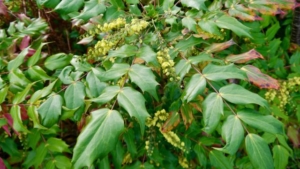Happy New Year to all readers. Celebrate the New Year with a feast for the birds and the bees.
Leave a few unwanted or spoiled apples on the lawn for the blackbirds, they like to feed on the ground. Stock up a feeder with seeds and nuts. Make sure there is accessible water in the garden, it can be as simple as leaving a bucket to fill with rainwater, or a shallow pot saucer tucked in among plants in the border.

Winter jasmine
Flowering shrubs provide nectar for the few bumble bees that start bumbling about on the occasional warm day. They also provide a necessary boost to human morale, which may be at a low ebb in the short days of January. Scented, small flowers in pale yellow send out beckoning signals in the cold clear air. Winter jasmine (Jasminum nudiflorum) will light up almost any position, no garden should be without this cheerful, useful plant. More space is needed for the Oregon grape (Mahonia in variety), but you do get the bonus of berries in the Autumn which the birds love. Thirty years ago I planted a then, to me, very expensive shrub, a witch hazel (Hamamelis mollis ‘Pallida’), it has rewarded me thirty-fold. Every year it produces stunning little sweep’s broom scented blooms from late December into February. Spend money! go and buy one in flower, scent and colour of your choice. They grow very slowly, but expect a spread of 3m after 30 years. Avoid very wet or dry soil, a north or west facing situation will be fine.

Mahonia japonica
Winter Chores:
Cut away dead or diseased leaves around hellebores to show the new blooms at their best.
It is a good time to cut deciduous hedges before the birds start nesting.
Wisterias will go on growing seemingly without limit (there’s one in Essex that is 252’ long) So it seems a good idea to keep them under control before you lose sight of your front door. They need pruning twice a year. To get the structure right, January-February is the time. Remembering that the more dramatic the pruning, the more vigorous the new growth will be , so balance is all. Don’t be tempted to over do it. Cut out the branches growing over roofs, gutters and otherwise causing a nuisance, cut them back to the main trunk. Cut out any branches that are rubbing, broken or congested. Next summer new shoots will have grown from the cut, you can choose one to tie in to the framework wires and cut out the rest. But for now cut back the long sideshoots from the main branches back to a couple of buds. This will encourage flowers at the expense of more leaves.

Cornus mas, tiny scented flowers



